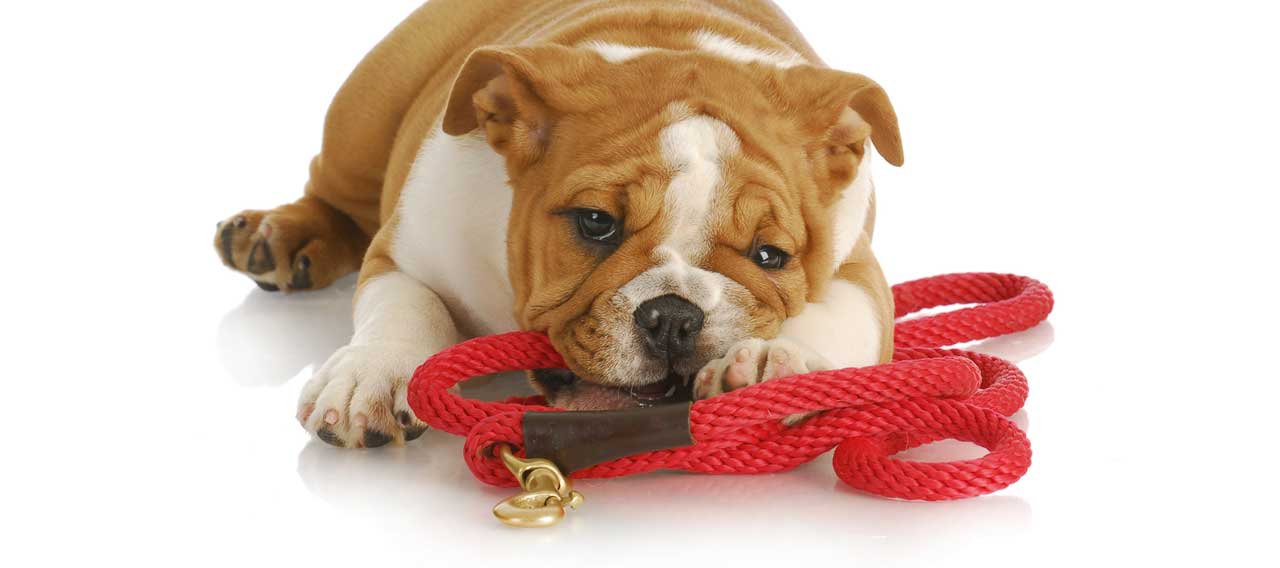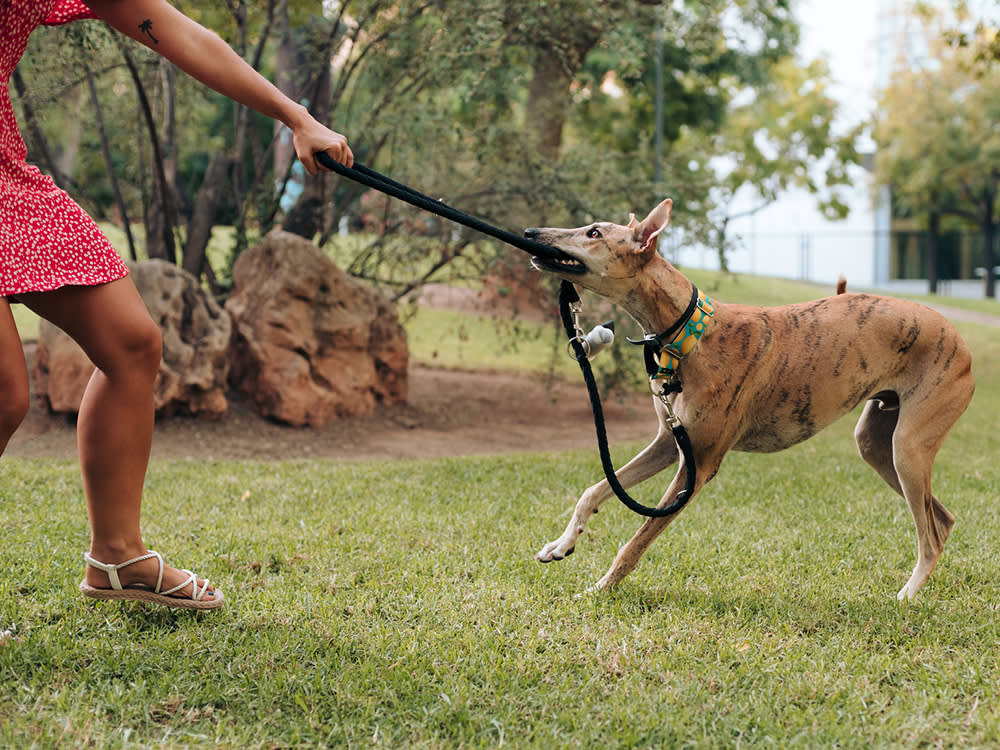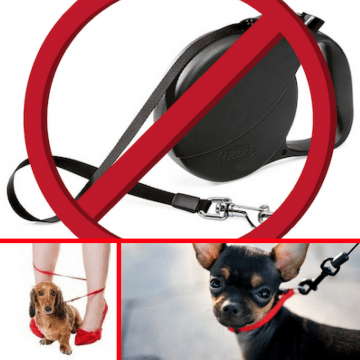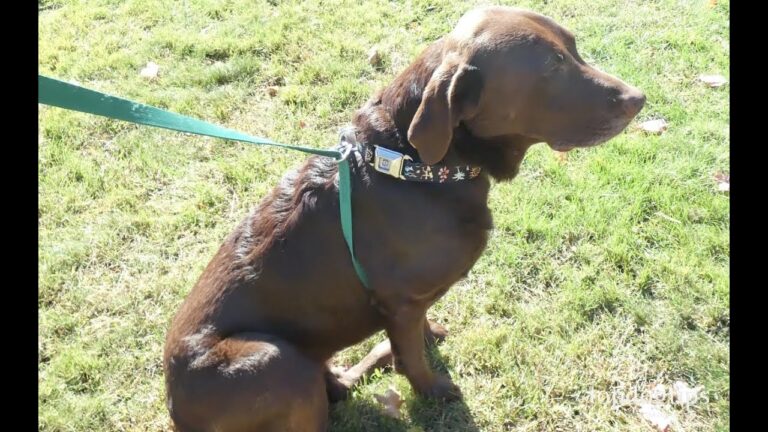Why Do Dogs Bite Their Leashes? Tips to Stop Biting
Last Updated on September 9, 2024 by Petpalace54
Dogs may bite their leashes due to frustration or excitement during walks. With proper training, this behavior can be stopped.
Walking your dog should be a peaceful and enjoyable activity for both you and your furry companion. However, when your dog starts biting their leash, it can become a frustrating and uncomfortable experience. Leash biting is usually a symptom of an underlying issue, such as boredom, anxiety, or overexcitement.
Therefore, it’s crucial to identify the root cause of this behavior and find ways to prevent it from happening. We’ll discuss the possible reasons why dogs bite their leashes and provide practical strategies to help you correct this problem. By following these tips, you can enjoy a more relaxed and safer walking experience with your dog.

Credit: genuinecanine.com
Table of Contents
Understanding Leash Biting In Dogs
Leash biting in dogs is often a sign of frustration or lack of training. Young and playful dogs tend to engage in this behavior, which can be prevented or eliminated with the right training techniques. High-value treats and diversion techniques can also help stop leash tugging and biting during walks.
Understanding Leash Biting in DogsIf you’re a dog owner who loves taking your furry friend for a walk, you’ve probably experienced leash biting. It’s frustrating when your dog chews the leash, making the walk uncomfortable and sometimes even dangerous. Understanding why dogs bite their leashes can help you prevent it from happening. In this article, we will discuss the reasons why dogs bite their leashes, the symptoms, and the consequences of this behavior.Reasons why dogs bite their leashesLeash biting in dogs can be caused by a variety of reasons, including:1. Anxiety: Dogs with a nervous disposition may chew their leash in response to unfamiliar, new, or overwhelming experiences.2. Excitement: If a dog is excited about the walk, they may chew the leash in anticipation.3. Frustration: Dogs that are not properly trained to walk on a leash may become frustrated and chew the leash.4. Boredom: Dogs that are not getting enough physical or mental stimulation may develop leash biting behavior.Symptoms of leash bitingThe symptoms of leash biting in dogs include:1. Chewing and biting the leash2. Shaking the leash3. Jumping while holding onto the leash4. Growling or barking at the leash5. Refusing to release the leashConsequences of leash bitingLeash biting can lead to a number of consequences, including:1. Damage to the leash that can render it unusable2. Increased risk of injury to the dog due to chewing on a potentially unsafe leash3. Increased frustration for the owner4. It can make walking the dog a difficult and unpleasant experienceTo prevent leash biting in dogs, training and positive reinforcement are key. Identifying the cause of the behavior and addressing it appropriately can help your furry friend overcome this habit. Follow these tips to prevent leash biting in dogs:1. Train your dog to walk on a leash properly2. Reward good behavior with treats and praise3. Provide your dog with enough physical and mental stimulation4. Use a shorter leash to prevent your dog from having the opportunity to bite itIn conclusion, understanding why dogs bite their leashes can help you prevent this behavior from happening. Be patient and consistent with your dog’s training, and with positive reinforcement, they can learn to enjoy their walks without chewing on the leash.Tips To Stop Leash Biting In Dogs
Leash biting in dogs may sometimes seem like a playful behavior, but it can stem from frustration or anxiety. Young, energetic dogs are especially prone to this behavior. Distracting with high-value treats and positive reinforcement can help stop this behavior.
Tips to Stop Leash Biting in DogsDogs biting their leashes can turn a seemingly relaxing walk into a frustrating and exhausting experience. It’s important to understand that leash biting is not just a bad behavior; it is often a symptom of a dog’s underlying needs. Luckily, with a bit of training, you can prevent or eliminate this behavior. Here are four tips to help stop leash biting in dogs.Practice Distraction Techniques
One way to stop your dog from biting their leash is by practicing distraction techniques. Bring high-value treats and toys while walking your dog. Whenever your dog starts to pull and bite on the leash, neutralize that behavior by distracting them with a high-value treat or toy. You can also try engaging them in games or giving them commands to divert their attention from the leash biting.Positive Reinforcement
Positive reinforcement is a great technique to encourage desirable behavior in your dog. Whenever your dog walks calmly without biting the leash, offer praise, treats, and petting. It’s important to stay consistent in your approach and not give mixed signals. Over time, your dog will learn that walking calmly without biting the leash leads to positive rewards.Use Of Alternative Equipment
Sometimes, leash biting behavior is due to the discomfort caused by the leash or collar. Consider using an alternative piece of equipment that is more comfortable for your dog, such as a harness. A harness distributes the pressure evenly around the body and prevents any undue pressure on the neck, which can cause discomfort and therefore, leash biting.Proper Exercise And Stimulation
Dogs that are bored, anxious, or lack exercise are likely to engage in unwanted behavior, such as leash biting. Ensure that your dog receives proper exercise and stimulation to help dissipate any pent-up energy or tensions. Take them for walks, runs, and play games like fetch. In conclusion, stopping leash biting behavior requires patience, consistency, and appropriate training techniques. By practicing diversion techniques, positive reinforcement, using alternative equipment, and providing proper exercise and stimulation, you can eliminate leash biting behavior in your dog while enjoying relaxed walks together.Training Techniques To Stop Leash Biting
Leash biting is a common behavior amongst young, playful, and excitable dogs and can be caused by frustration or confusion during leash walking. To prevent or eliminate leash biting, training techniques such as keeping a short leash, correcting the behavior, and providing distractions with high-value treats can be used.
Clicker training and teaching recall cues can also be effective.
Training Techniques to Stop Leash BitingLeash biting is a common problem that owners face while walking their dogs. Fortunately, there are several effective training techniques you can use to stop this behavior. In this article, we will discuss some of these techniques, which include clicker training, teaching basic obedience commands, counterconditioning, and desensitization.Clicker TrainingClicker training is a popular and effective method that uses a clicker to reward desired behavior. To stop leash biting, use the clicker when your dog doesn’t bite the leash. You can then reward your dog with a treat and praise. Your dog will learn that not biting the leash leads to rewards.Teaching Basic Obedience CommandsTeaching basic obedience commands such as ‘leave it’ is essential to stop leash biting. When your dog begins to bite on the leash, use the ‘leave it’ command. By practicing this command, your dog will learn to stop biting the leash and focus on you. This technique will also help your dog develop better self-control and reduce anxiety.CounterconditioningCounterconditioning is a process of teaching your dog to react positively to a specific stimulus that he previously reacted negatively to. To use this technique, you can offer your dog a treat or toy when you put on the leash. Over time, your dog will begin to associate the leash with positive experiences instead of frustration and anxiety.DesensitizationDesensitization is a process by which your dog’s negative reaction to a stimulus is gradually reduced. To use this technique, start by leaving the leash out for your dog to investigate without putting it on. When your dog shows calm behavior around the leash, reward him with a treat or praise. Slowly progress to putting the leash on, without going for a walk, and then gradually increase walk duration.In conclusion, leash biting is a common problem, but it can be stopped using these training techniques. It is essential to start with the training in a calm environment and gradually increase the difficulty. Remember to be consistent with your training and always use positive reinforcement to encourage good behavior.
Credit: m.youtube.com
Preventive Measures To Stop Leash Biting
Leash biting in dogs is a common behavior that is often attributed to frustration or excitement. By keeping a shorter leash length and providing high-value treats as a distraction, this behavior can be corrected and prevented with proper training techniques.
Preventive Measures to Stop Leash Biting:Leash biting is a bad habit that can be frustrating for pet owners. Luckily, there are several preventive measures you can take to stop your dog from biting their leash. Here are some effective ways to prevent leash biting:H3: Choose appropriate equipmentMake sure to choose comfortable and appropriate equipment for your dog. Some dogs may feel uncomfortable or restricted in certain types of collars or leashes, which may lead to leash biting.H3: Take breaks during walksTaking breaks during walks can help prevent over-stimulation, which may cause dogs to bite their leash. Give your dog a chance to rest and calm down, and consider reducing the length of your walks if they are too long or tiring.H3: Avoid over-stimulating environmentsAvoid taking your dog to over-stimulating environments such as busy streets or crowded parks, as these can cause anxiety and stress in dogs. Stick to quieter areas where your dog can feel more relaxed and comfortable.H3: Teach dogs to release objects on commandTeaching your dog to release objects on command can help prevent leash biting, as it trains them to follow your commands and release the leash when told to do so. Practice this command during training sessions and always reward your dog for following your commands.By implementing these preventive measures, you can help stop your dog from biting their leash. Remember to always be patient and consistent during training, and never punish your dog for leash biting. With time and effort, you can teach your pet to walk calmly on a leash without any biting or tugging.Common Mistakes Owners Make When Dealing With Leash Biting
Leash biting is a common behavior displayed by dogs and is often a sign of frustration or lack of understanding about leash walking. Pups who are anxious or excited about walks are often seen biting their leashes. Training and proper diversion techniques can help prevent or eliminate this behavior.
Common Mistakes Owners Make when Dealing with Leash BitingWhen it comes to leash biting, dog owners often make common mistakes that can exacerbate the behavior. Punishing dogs for leash biting, using inappropriate training equipment, failing to address underlying behavioral or mental health issues, and neglecting exercise and mental stimulation needs can all contribute to leash biting. Understanding the underlying causes of this behavior and addressing them correctly can help prevent or eliminate it.H3: Punishing dogs for leash bitingPunishing dogs for leash biting is a counterproductive approach that can make the problem worse. Dogs do not understand punishment in the same way that humans do and may become anxious or fearful, leading to further behavioral issues. Instead, try redirecting the behavior by offering an appropriate chew toy or treat to distract them from biting the leash. Positive reinforcement for good behavior can also be effective in eliminating leash biting.H3: Using inappropriate training equipmentUsing inappropriate training equipment can also contribute to leash biting. Choosing a collar or harness that is uncomfortable or too tight can cause pain and discomfort, leading to frustration or anxiety that can trigger leash biting. It is important to select equipment that is appropriate for your dog’s size, breed, and activity level. Consult a professional dog trainer or veterinarian for advice on the best equipment to use.H3: Failing to address underlying behavioral or mental health issuesLeash biting can also be a symptom of other underlying behavioral or mental health issues. Anxiety, fear, and frustration are common causes of leash biting and should be addressed with appropriate training and behavioral interventions. If your dog’s leash biting is persistent or excessive, seeking the help of a professional dog trainer, veterinarian, or animal behaviorist may be necessary.H3: Neglecting exercise and mental stimulation needsDogs that are not getting enough exercise and mental stimulation may resort to leash biting as a way to release excess energy or anxiety. It is important to provide your dog with daily exercise and playtime, along with mental stimulation activities such as puzzle toys, interactive games, and training sessions. A tired and mentally stimulated dog is less likely to resort to leash biting.In conclusion, understanding and addressing the underlying causes of leash biting is key to preventing or eliminating the behavior. By avoiding common mistakes such as punishment, using inappropriate training equipment, failing to address underlying issues, and neglecting exercise and mental stimulation needs, you can help your dog become a well-behaved and happy companion on walks.:strip_icc()/dog-bite-prevention-1117453-FINAL-d2d6e8c12f164292aabbeadc7765deb2.png)
Credit: www.thesprucepets.com
Frequently Asked Questions On Why Do Dogs Bite Their Leashes
Why Do Dogs Put Their Leash In Their Mouth?
Leash biting in dogs can be a result of frustration or a lack of understanding about leash walking. It’s common among young and excitable dogs. Training can help prevent or eliminate this behavior. High-value treats and clicker training can help distract dogs from biting the leash.
Anxiety or excitement can also be causes.
How Do I Get My Dog To Stop Biting And Tugging On The Leash?
To stop your dog from biting and tugging the leash, bring high-value treats and distract them when they start pulling. Practice at home first and consider clicker training. Leash biting can be caused by anxiety or excitement, so make sure your dog is adequately stimulated.
With training, leash biting can be prevented or eliminated.
Why Does My Dog Grab His Own Leash?
Dogs often grab their leash due to excitement, nervousness or frustration. Young, playful dogs tend to bite and chew on the leash. Proper leash training and providing enough stimulation can prevent or eliminate this behavior. Using high-value treats and distraction techniques can also help a dog stop biting the leash.
Why Do Dogs Bite When You Grab Their Collar?
Dogs may bite when you grab their collar because they associate the experience with unpleasant consequences, such as confinement or leaving a fun place. If they are anxious or excited, they may also chew on the leash to release tension or express their feelings.
Training can help prevent or eliminate this behavior.
Conclusion
Leash biting is not just a bad habit but often a sign of frustration or lack of understanding of leash walking by dogs. It may also indicate anxiety or excitement. However, by providing distraction with high-value treats or having tugging and biting toys at home, one can curb this behavior in dogs.
Training and positive reinforcement can go a long way in correcting the behavior and making leash walking a more enjoyable experience for both the pets and their owners.





